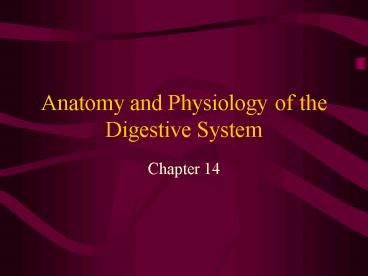Anatomy and Physiology of the Digestive System - PowerPoint PPT Presentation
1 / 30
Title:
Anatomy and Physiology of the Digestive System
Description:
Anatomy and Physiology of the Digestive System. Chapter 14. Groups of Organs ... Functions of the Digestive System. Ingestion. Propulsion- peristalsis and ... – PowerPoint PPT presentation
Number of Views:8752
Avg rating:3.0/5.0
Title: Anatomy and Physiology of the Digestive System
1
Anatomy and Physiology of the Digestive System
- Chapter 14
2
Groups of Organs
- Alimentary canal ingests, digests, absorbs and
defecates - Accessory digestive organs-
3
GI Tract or Alimentary Canal
- Continuous coiled, hollow, muscular tube
- Includes mouth, pharynx, esophagus, stomach,
small intestine, large intestine, anus
4
Mouth
- Oral Cavity mucous membrane-lined cavity
- Lips (labia)
- Cheeks
- Hard palate
- Soft palate
- Uvula
- Vestibule and oral cavity proper
- Tongue
5
Pharynx
- Nasopharynx, oropharynx and the laryngopharynx
- Peristalsis occurs here
6
Esophagus
- Gullet
- Consists of 4 tissue layers or tunics
- Mucosa
- Submucosa
- Muscularis externa- circular and longitudinal
muscles - Serosa
7
Stomach- external
- Cardioesophageal sphincter
- Fundus
- Body
- Pylorus
- Pyloric sphincter
- Rugae
- Greater and Lesser Curvature
- Greater and lesser omentum (peritoneum)
- Longitudinal, circular and the oblique muscularis
externa- churning and mixing
8
Stomach - internal
- The lining of the stomach is dotted with gastric
pits leading into gastric glands that secrete
gastric juice - Some cells secrete intrinsic factor (needed for
Vit B12 absorbtion) - Chief cells produce pepsinogens (protein
digestion) - Parietal cells produce HCl
- Food processed by the stomach is called chyme
- http//www.peterjurek.com/rbv_site/web_pages/stoma
ch.html
9
Small Intestine
- Bodys major digestive organ
- Starts at the pyloric sphincter and ends at the
ileocecal valve - Average length of 6-13 feet
10
3 divisions
- Duodenum-contains pancreatic ducts and bile duct
- Jejunum
- Ileum
- Nearly all food absorption occurs in the small
intestine
11
Internal Anatomy
- Microvilli- tiny projections (brush border)
- Villi- fingerlike projections, contain rich
capillary bed - Circular folds- deep folds of mucosa and
submucosa layers - Peyers patches- lymphatic tissue found in the
submucosa
12
Large Intestine
- About 5 feet long
- Extends from the ileocecal valve to the anus
- Frames the small intestine on 3 sides
13
Divisions
- Cecum
- Appendix
- Colon- distinct regions
- Ascending colon, transverse colon and descending
colon, sigmoid colon - Rectum
- Anal canal
14
Accessory Digestive Organs
- 3 pairs of salivary glands
- Teeth
- Pancreas
- Liver
- Gallbladder
15
Salivary Glands
- Parotid glands- anterior to the ears
- Submandibular glands- floor of mouth
- Sublingual glands- floor of mouth
- Produce salivary amylase- starts starch
digestion, contains lysozyme and IgA, dissolves
food chemicals enhancing taste
16
Teeth
- Mastication
- Deciduous teeth/permanent teeth
- Wisdom teeth- 3rd set of molars
- Impacted teeth
- 32 permanent teeth is a full set
17
Classification of Teeth
- Based on shape and function
- Incisors-cutting
- Canines-tearing or piercing
- Premolars-grinding
- Molars-grinding
18
Anatomy of the Tooth
- Crown- visible
- Enamel
- Dentin- bone-like material
- Root- below the gingiva (gum)
- Cementum attaches the tooth to the periodontal
membrane (ligament that holds tooth in place) - Neck- connects the crown and the root
19
Pancreas
- Produces hormones insulin and glucagon and
digestive enzymes
20
Liver
- Largest organ
- 4 lobes
- Produces bile which leaves via the common hepatic
duct
21
Gallbladder
- Stores bile
- Enters via the cystic duct
- Eating fatty foods stimulates the gallbladder to
contract and spurt out stored bile
22
Disease
- Gallstones, gallbladder attack
- Jaundiced
- Hepatitis- inflammation of the liver
- Cirrhosis of the liver hard and fibrous
23
Functions of the Digestive System
- Ingestion
- Propulsion- peristalsis and segmentation
- Mechanical digestion
- Chemical digestion
- Absorption
- Defecation
24
Food ingestion and breakdown
- Physical- mastication
- Tongue helps form bolus
- Chemical- salivary amylase
- Pharynx and esophagus
25
Food Propulsion
- Swallowing
- Buccal phase-food enters pharynx
- Pharyngeal-esophageal phase
- Tongue blocks off mouth
- Soft palate closes off nasal passages
- Larynx rises and epiglottis blocks respiratory
tract - Pressure on cardioesophageal sphinctor
26
Stomach
- Gastric juice
- Gastrin- hormone that stimulates stomach
- 2-3 liters of gastic juice daily
- Mucus- ulcers
- Chemical- pepsinogen, Rennin
- Physical- churning
27
Food Propulsion
- The pylorus of the stomach holds about 30ml of
chyme - The pyloric sphincter squirts about 3ml or less
into the sm. Int. - This process takes 4-6 hours
28
Small Intestine
- Chemical- 3-6 hours for food to travel through
the sm int - Brush border enzymes
- Pancreatic juice- pancreatic amylase, trypsin,
chymotrypsin, carboxypeptidase, lipases,
nucleases, bicarbonate (brings pH up to 8) - Hormonal control- secretin and cholecystokinin
(CCK) - Mechanical- bile
- Propulsion- peristalsis
29
Large Intestine
- 12-24 hours
- About 500ml of flatus is produced daily
- Resident bacteria make vitamin K and some B
vitamins - Absorbtion is only vitamins, some ions, water
- Feces
- Peristalsis and mass movements
30
Disease
- Heartburn
- ulcers































